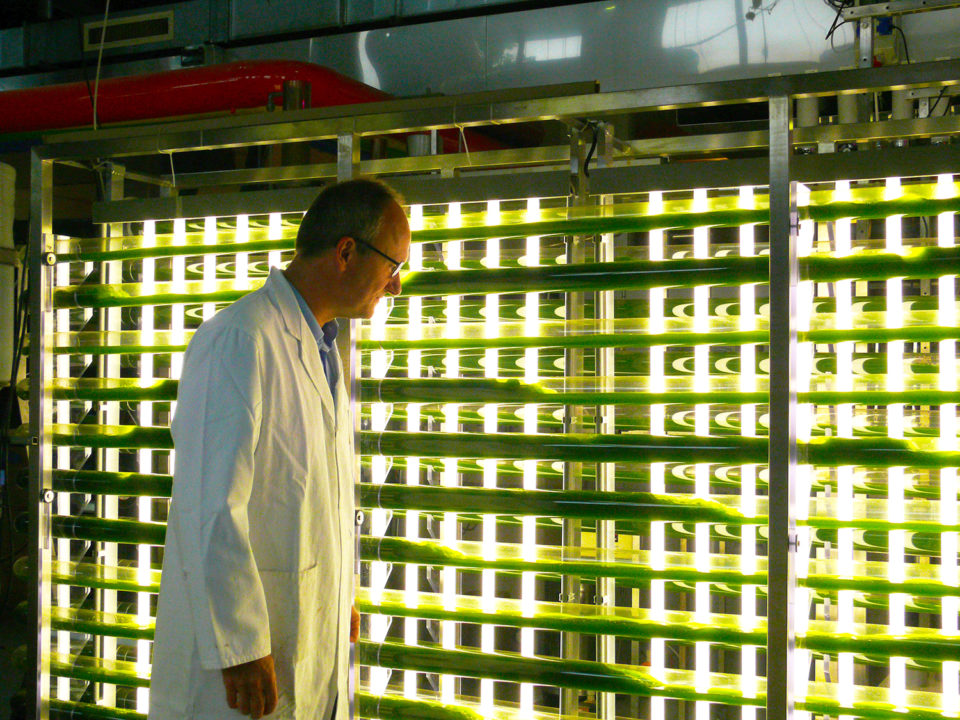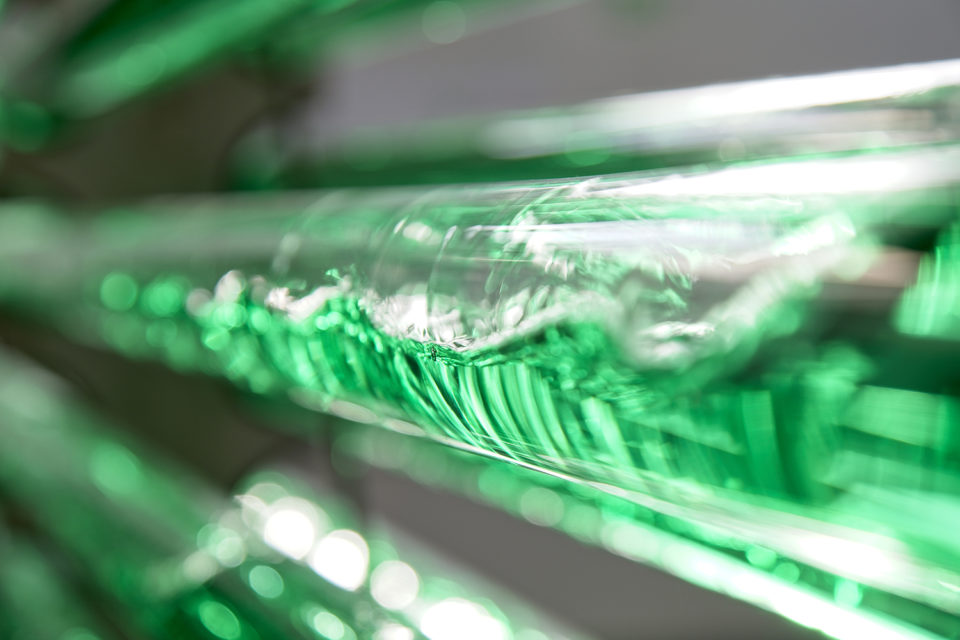Aquaculture hatcheries seek less energy-intensive methods for crucial feedstock

With high amounts of protein, vitamins, minerals and the essential fatty acids known as omega-3s, microalgae play a key nutritional role in larval shellfish culture. But they cost a lot to produce. The intensive rearing of bivalves like oysters, clams and scallops relies on the production of live algae, which is 30 percent of a hatchery’s operating costs.
“The cost price per kilogram of algae is too high because of the demand for labor, water and energy,” said Sander Hazewinkel, founder, co-owner and chief commercial officer of Dutch firm LGem. “It’s currently around 300 to 900 euros. If it can be reduced to 100 euros or more, depending on the amount of algae required, the bigger your operation is, the cheaper it will become to a certain point.”
Established in 2006, LGem designs and manufactures turnkey microalgae photobioreactors. After examining various algae production systems –from plastic bags and bubble columns to PVC tubes – the company launched GemTube, a glass tubular helix system that offers extreme durability and a more simplified, cost-effective form of algae production.
LGem discovered that conventional production systems use a lot of power and aeration for circulation and to prevent biofouling and oxygen build-up. To address this, two of the company’s patented technologies – Wavywind and Bubblebrush – were incorporated into the GemTube. Liquid and air run through the tubes like waves, propelling the system and creating circulation with limited energy.
Wavywind allows a stream of air to travel at twice the velocity of the culture fluid. This creates eddies on the liquid surface and a stirring effect that gives a desired light-dark cycle below 1 hertz. Bubblebrush produces a series of bubbles that accompanies the waves and keeps the walls of the tubes clear without the need for fast pumping. This improves the quality and productivity of algae culture.

“Air moving through the glass tubes removes oxygen and supplies carbon dioxide evenly over the whole tubular helix at 100 watts per 1,000 liters of culture, or one-tenth of the energy input of conventional tubular systems,” said Hazewinkel. “No centrifugal pumps are needed because the moving air propels the entire system. This means that we can also operate our system with just an air source and without any moving parts. This is particularly interesting for aquaculture because it often produces fragile species like Rhodomonas and Isochrysis. These perform very well in the GemTube.”
Meanwhile, research at Wageningen University in the Netherlands has highlighted differences in production costs per kilogram of algal biomass depending on the systems used and whether artificial light was incorporated. The RAAQUA (Robust Algae cultivation in AQUAculture) project evaluated the cost price of microalgae production in hatcheries by comparing bubble-column systems with tubular photobioreactors under two scenarios: artificial light and sunlight with reactors located in a greenhouse.
https://www.aquaculturealliance.org/advocate/bridging-the-omega-3-gap-with-methane-microalgae/
Researcher Pieter Oostlander found that increasing light levels and maintaining growth parameters at optimal values could reduce algae production costs.
“Scalable production systems are always more cost efficient for aquaculture applications,” he said. “Artificial light is advised as it allows good control over all growth conditions. We were able to combine detailed information about the effects of growth conditions (light and temperature) on the efficiency of light use by the algae and calculate optimized conditions for cost efficient production in all reactor scenarios.”
“Hatcheries can reduce costs and produce algae on a larger scale by using scalable photobioreactors and knowing the impact of growth conditions on photosynthetic efficiency,” he said.
LGem’s GemTube has drawn the attention of U.S. firm Taylor Shellfish, which uses bags and tanks to produce liquid algae including Isochrysis, Chaetoceros, Pavlova and Tetraselmis for shellfish feed. About 130 to 150,000 litres is harvested each day from a combination of static and flow through tanks as well as over 200 bags.
“We usually have seven or eight species in our system to bring in all essential elements for our shellfish,” said Taylor Shellfish Research Director Benoit Eudeline. “Our system’s overall flexibility, diversity and consistency are huge and even if some species stopped growing, we have others that would offer more or less the same lipid profile so there is no impact on shellfish growth.”

Eudeline believes that the GemTube could make Taylor’s algae production more efficient in terms of increasing light availability, decreasing contamination issues and using relatively little space. It can also be operated in highly controlled conditions and designed and optimized in accordance with the algae strain of choice.
However, high costs must be considered, he said.
“Replacing our system completely can be a tough proposition as it requires a lot of money,” he said. “It has to make sense and we have to make our production as cost efficient as possible but that’s only one aspect of the whole story. You might have a system that makes algae production more cost efficient but if it isn’t flexible or you cannot ensure continuous production or add different species, it becomes much more costly.”
Eudeline says that the key is to determine how photobioreactors like the GemTube could fit into existing production systems. With system construction and operation, space, equipment and labor all significant costs in algae production, incorporating something new like the GemTube could be worthwhile, especially if there are less steps and labor.
“Integrating such a system and producing a consistent supply of algae is extremely important,” he said. “Saving money is one thing but that’s very small compared to consistent and reliable production.”
Jessica Harvey, scallop hatchery technician at the National Marine Aquarium in Plymouth, UK, agrees. To ease the pressure from commercial scallop fishing, Harvey and her team produce viable king scallop (Pecten maximus) seed. A combination of conical flasks and bag culture is their primary method of producing algae, a food source for scallop broodstock as well as juvenile fish and other shellfish.
“We produce flagellates and diatoms at different cell sizes to ensure suitability for different life stages,” said Harvey. “We produce large volumes of live algae for feed with minimal maintenance and culture a variety of species within a small area.”
The GemTube is likely to be a future consideration, she said, if the scale of her hatchery’s operation grows. In the meantime, she believes that algae production costs can be reduced as follows.
“It’s important to establish connections with algae suppliers or local producers of stocks so if you were to require some at short notice, you have a higher chance of doing so,” she said. “Investing in training for technicians regarding common issues and how to mitigate them, such as biosecurity, can also help.”
Follow the Advocate on Twitter @GAA_Advocate
Now that you've finished reading the article ...
… we hope you’ll consider supporting our mission to document the evolution of the global aquaculture industry and share our vast network of contributors’ expansive knowledge every week.
By becoming a Global Seafood Alliance member, you’re ensuring that all of the pre-competitive work we do through member benefits, resources and events can continue. Individual membership costs just $50 a year. GSA individual and corporate members receive complimentary access to a series of GOAL virtual events beginning in April. Join now.
Not a GSA member? Join us.
Author
-

Bonnie Waycott
Bonnie Waycott is a freelance writer specializing in aquaculture development and fisheries management, with a particular focus on Japan. She has a keen interest in the recovery of aquaculture in Tohoku, following the Great East Japan Earthquake and Tsunami of March 2011.
Tagged With
Related Posts

Innovation & Investment
Algae innovators aim to freeze out early-stage shrimp losses
A greenhouse in Belgium believes its innovative shrimp feed product, made from freeze-dried microalgae, packs the necessary nutrients for the crustacean’s most vulnerable life stage: the first three days of its life.

Aquafeeds
Veramaris runs away with F3 oil-alternative contest
The DSM-Evonik joint venture won the F3 Fish Oil Challenge by a wide margin. CEO Karim Kurmaly talks about the “sacrifice” his team made to win.

Innovation & Investment
Aquafeed ingredient AlgaPrime wins GAA Innovation Award
A proliferation of alternative feed ingredients has allowed aquaculture to extend the natural resources it depends on. AlgaPrime, packed with the long-chain omega-3 fatty acid DHA, is being recognized as a game-changing innovation for aquaculture feeds.

Aquafeeds
Pond-cultivated algae: Slimy superhero for aquafeeds?
Qualitas Health, which grows algae in ponds in New Mexico and Texas for human supplements, is entering the alternative aquafeed ingredient market.

